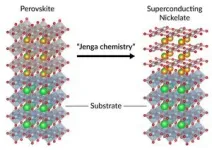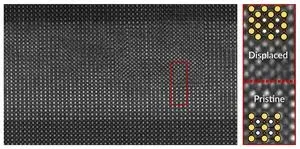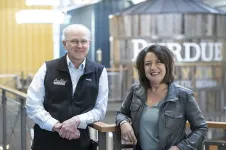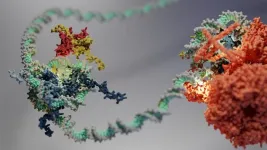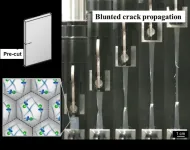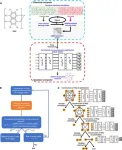(Press-News.org) Researchers at the Department of Energy’s SLAC National Accelerator Laboratory and Stanford University say they’ve found a way to make thin films of an exciting new nickel oxide superconductor that are free of extended defects.
Not only does this improve the material’s ability to conduct electricity with no loss, they said, but it also allows them to discover its true nature and properties, both in and out of the superconducting state, for the first time.
Their first look at a superconducting nickel oxide, or nickelate, that does not have defects revealed that it is more like the cuprates – which hold the world’s high-temperature record for unconventional superconductivity at normal pressures – than previously thought. For instance, when the nickelate is tweaked to optimize its superconductivity and then heated above its superconducting temperature, its resistance to the flow of electric current increases in a linear fashion, just as in cuprates.
Those striking similarities, they said, may mean these two very different materials achieve superconductivity in much the same way.
It's the latest step in a 35-year quest to develop superconductors that can operate at close to room temperature, which would revolutionize electronics, transportation, power transmission and other technologies by allowing them to operate without energy-wasting electrical resistance.
The research team, led by Harold Hwang, director of the Stanford Institute for Materials and Energy Sciences (SIMES) at SLAC, described their work today in the journal Nature.
“Nickelate films are really unstable, and until now our efforts to stabilize them on top of other materials have produced defects that are like speed bumps for electrons,” said Kyuho Lee, a SIMES postdoctoral researcher who contributed to the discovery of superconductivity in nickelates four years ago and has been working on them ever since.
“These quality issues have led to many debates and open questions about nickelate properties, with research groups reporting widely varying results,” Lee said. “So eliminating the defects is a significant breakthrough. It means we can finally address the underlying physics behind these materials and behind unconventional superconductivity in general.”
Jenga chemistry and a just-right fit
The defects, which are a bit like misaligned zipper teeth, arise from the same innovative process that allowed Hwang’s team to create and stabilize a nickelate film in the first place.
They started by making a common material known as perovskite. They “doped” it to change its electrical conductivity, then exposed it to a chemical that deftly removed layers of oxygen atoms from its molecular structure, much like removing a stick from a tower of Jenga blocks. With the oxygen layers gone, the film settled into a new structure – known as an infinite-layer nickelate –that can host superconductivity.
The atomic latticework of this new structure occupied a slightly bigger surface area than the original. With this in mind, they had built the film on a foundation, or substrate, that would be a good fit for the finished, spread-out product, Lee said.
But it didn’t match the atomic lattice of the starting material, which developed defects as it tried to fit comfortably onto the substrate – and those imperfections carried through to the finished nickelate.
Hwang said it’s as if two friends of different sizes had to share a coat. If the coat fit the smaller friend perfectly, the larger one would have a hard time zipping it up. If it fit the larger friend perfectly, it would hang like a tent on the smaller one and let the cold in. An in-between size might not be the best fit for either of them, but it’s close enough to keep them both warm and happy.
That’s the solution Lee and his colleagues pursued.
In a series of meticulous experiments, they used a substrate that was like the in-between coat. The atomic structure of its surface was a close enough fit for both the starting and ending materials that the finished nickelate came out defect-free. Lee said the team is already starting to see some interesting physics in the nickelate now that the system is much cleaner.
“What this means,” Hwang said, “is that we are getting closer and closer to measuring the intrinsic properties of these materials. And by sharing the details of how to make defect-free nickelates, we hope to benefit the field as a whole.”
Researchers from Cornell University contributed to this work, which was funded by the DOE Office of Science and the Gordon and Betty Moore Foundation’s Emergent Phenomena in Quantum Systems Initiative.
Citation: Kyuho Lee et al., Nature, 12 July 2023 (10.1038/s41586-023-06129-x)
SLAC is a vibrant multiprogram laboratory that explores how the universe works at the biggest, smallest and fastest scales and invents powerful tools used by scientists around the globe. With research spanning particle physics, astrophysics and cosmology, materials, chemistry, bio- and energy sciences and scientific computing, we help solve real-world problems and advance the interests of the nation.
SLAC is operated by Stanford University for the U.S. Department of Energy’s Office of Science. The Office of Science is the single largest supporter of basic research in the physical sciences in the United States and is working to address some of the most pressing challenges of our time.
END
A foundation that fits just right gives superconducting nickelates a boost
It irons out wrinkles in thin films of these novel superconductors so scientists can see their true nature for the first time
2023-07-12
ELSE PRESS RELEASES FROM THIS DATE:
New study using human fibroid cells supports use of green tea compound as treatment for uterine fibroids
2023-07-12
In a pre-clinical, proof-of-concept study from Johns Hopkins Medicine, researchers found that epigallocatechin gallate (EGCG), a green tea compound with powerful antioxidant properties, could be promising for both treating and preventing uterine fibroids. Results of the study, first posted online May 25 in Scientific Reports, add to growing evidence that EGCG may reduce fibroid cell growth. The study was specifically designed to identify the biochemical mechanisms responsible for EGCG action in fibroid cells.
The investigators emphasize that their study involves human fibroid cells grown in the laboratory and treated with EGCG extract to explore the possibility of oral EGCG supplementation ...
The good advice that could lift people out of poverty
2023-07-12
Providing access to housing, debt, and benefit advice within food banks could help lift people out of poverty - according to a University of East Anglia study.
Researchers worked with Norwich Foodbank centres, part of the Trussell Trust, on a pilot project that saw representatives from Citizens Advice and Shelter posted within the service.
The ‘Making a Difference’ initiative meant that people forced to use a food bank were also able to access advice on a range of issues - from housing and debt to benefits.
It is now hoped that this scheme will be rolled out to foodbanks nationally.
Lead researcher Dr Sarah Hanson, from UEA’s School of ...
Amplified Sciences receives $400,000 NCI grant to improve early detection of pancreatic cancer
2023-07-12
WEST LAFAYETTE, Ind. – Health care providers and their patients could know with greater confidence whether pancreatic cysts are benign or potentially malignant, and if surgery is required to remove them, by using a new diagnostic test currently in development.
Amplified Sciences, a clinical-stage life sciences diagnostic company that licenses Purdue University innovations, has received a Phase I Small Business Innovation Research, or SBIR, grant of approximately $400,000 from the National Cancer Institute (NCI) to develop the test. The company focuses on accurately detecting and categorically assessing the risks of debilitating ...
Birmingham start-up awarded funding for technology that generates water out of air
2023-07-12
NovNat Tech Ltd, a visionary new company based in the Unit 9 incubator at the Birmingham Research Park, has secured funding from Innovate UK to develop a novel technology that can generate water out of air.
NovNat Tech is offering solutions to one of the most critical problems of today and the future, the global water scarcity crisis, and is developing a first of its kind ‘atmospheric water harvester’ to help address the global water shortage.
The harvest uses a proprietary material that has already been ...
Webb celebrates first year of science with close-up on birth of sun-like stars
2023-07-12
From our cosmic backyard in the solar system to distant galaxies near the dawn of time, NASA’s James Webb Space Telescope has delivered on its promise of revealing the universe like never before in its first year of science operations. To celebrate the completion of a successful first year, NASA has released Webb’s image of a small star-forming region in the Rho Ophiuchi cloud complex.
“In just one year, the James Webb Space Telescope has transformed humanity’s view of the cosmos, peering ...
Lupus Research Alliance announces recipients of 2023 Diversity in Lupus Research Awards
2023-07-12
NEW YORK, NY, July 12. The Lupus Research Alliance is pleased to announce the 2023 recipients of the Career Development and Postdoctoral Awards to Promote Diversity in Lupus Research. The Diversity in Lupus Research Awards aim to foster the development of outstanding, underrepresented minority scientists and establish a diverse community of researchers and clinicians in the field of lupus.
Lupus is a debilitating autoimmune disorder, and the prevalence, severity of symptoms, and mortality are higher among people of color. Yet a recent report by the National Science Foundation showed that while “Blacks or African Americans, Hispanics or Latinos, ...
A glimpse into the hexasome: 40 years on
2023-07-12
In 1983, scientists discovered hexasomes – a unique molecular structure that helps cells package their DNA. Now, a study conducted by the Eustermann group at EMBL Heidelberg has shed light on how DNA packaging into hexasomes can affect the function of enzymes involved in gene regulation.
DNA: a lot to unpack
DNA is a very long, thin thread containing our genetic instructions. Being much longer than the tiny space inside our cells, it needs a clever packaging system. That’s where nucleosomes come into play – tiny spool-like structures that help compact our genetic information. Multiple nucleosomes are then linked ...
Award for dementia researcher from New York City
2023-07-12
This year’s “Hartwig Piepenbrock-DZNE Prize”, endowed with 60,000 euros, goes to the British neuroscientist Alison Goate, DPhil. The award recognizes her outstanding contributions to research into Alzheimer’s disease and frontotemporal dementia. Professor Goate researches and teaches at the Icahn School of Medicine at Mount Sinai, an international leader in biomedical education, research, and patient care located in New York City. The prize is presented jointly by the Piepenbrock Group and the German Center for Neurodegenerative Diseases (DZNE). The award ...
Towards crack-resistant nanoparticle-based latex films
2023-07-12
Synthetic polymer materials, such as plastics and rubbers, have become ubiquitous in our daily lives. It is, therefore, essential to ensure that they are safe, durable, and sustainable. This is especially true for synthetic latex films, which are widely used in packaging, biomedicine, and electronics.
But what exactly are synthetic latex films? Simply put, they are a type of nanoparticle-based films that are produced by drying out a mixture of polymer nanoparticles and water. As the solvent evaporates, the nanoparticles become more packed until finally the interactions between polymer chains at the boundaries of nanoparticles create a coherent film. Unfortunately, the latex films ...
Better and faster design of organic light-emitting materials with machine learning and quantum computing
2023-07-12
Over the past decade, organic luminescent materials have been recognized by academia and industry alike as promising components for light, flexible and versatile optoelectronic devices such as OLED displays. However, it is a challenge to find suitably efficient materials.
To address this challenge, a joint research team has developed a novel approach combining a machine learning model with quantum-classical computational molecular design to accelerate the discovery of efficient OLED emitters. This research was published May 17 in Intelligent Computing, a Science Partner Journal.
The ...
LAST 30 PRESS RELEASES:
Many mothers in Norway do not show up for postnatal check-ups
Researchers want to find out why quick clay is so unstable
Superradiant spins show teamwork at the quantum scale
Cleveland Clinic Research links tumor bacteria to immunotherapy resistance in head and neck cancer
First Editorial of 2026: Resisting AI slop
Joint ground- and space-based observations reveal Saturn-mass rogue planet
Inheritable genetic variant offers protection against blood cancer risk and progression
Pigs settled Pacific islands alongside early human voyagers
A Coral reef’s daily pulse reshapes microbes in surrounding waters
EAST Tokamak experiments exceed plasma density limit, offering new approach to fusion ignition
Groundbreaking discovery reveals Africa’s oldest cremation pyre and complex ritual practices
First breathing ‘lung-on-chip’ developed using genetically identical cells
How people moved pigs across the Pacific
Interaction of climate change and human activity and its impact on plant diversity in Qinghai-Tibet plateau
From addressing uncertainty to national strategy: an interpretation of Professor Lim Siong Guan’s views
Clinical trials on AI language model use in digestive healthcare
Scientists improve robotic visual–inertial trajectory localization accuracy using cross-modal interaction and selection techniques
Correlation between cancer cachexia and immune-related adverse events in HCC
Human adipose tissue: a new source for functional organoids
Metro lines double as freight highways during off-peak hours, Beijing study shows
Biomedical functions and applications of nanomaterials in tumor diagnosis and treatment: perspectives from ophthalmic oncology
3D imaging unveils how passivation improves perovskite solar cell performance
Enriching framework Al sites in 8-membered rings of Cu-SSZ-39 zeolite to enhance low-temperature ammonia selective catalytic reduction performance
AI-powered RNA drug development: a new frontier in therapeutics
Decoupling the HOR enhancement on PtRu: Dynamically matching interfacial water to reaction coordinates
Sulfur isn’t poisonous when it synergistically acts with phosphine in olefins hydroformylation
URI researchers uncover molecular mechanisms behind speciation in corals
Chitin based carbon aerogel offers a cleaner way to store thermal energy
Tracing hidden sources of nitrate pollution in rapidly changing rural urban landscapes
Viruses on plastic pollution may quietly accelerate the spread of antibiotic resistance
[Press-News.org] A foundation that fits just right gives superconducting nickelates a boostIt irons out wrinkles in thin films of these novel superconductors so scientists can see their true nature for the first time

